Fishing Pier Removal
Many of us I am sure have walked out on big floating fishing piers that are scattered around the country in various lakes, streams or whatever. Some of us may have even dipped a fishing line off one and probably taken pictures as well. But have you ever given thought to just what is involved in to the removal of those things especially in the northern lakes. One of the last big jobs I worked on before the season ended for us at Otsego Lake State Park was the removal of the parks fishing pier. Now as you can see by the pictures, this is no teeny little dock.
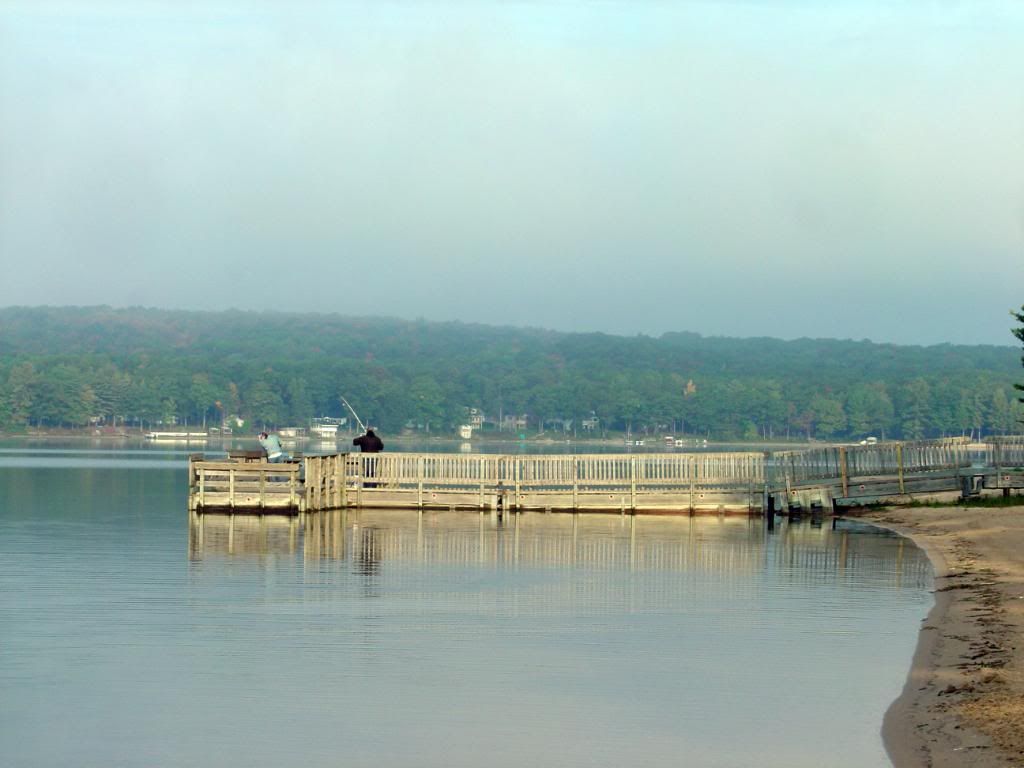

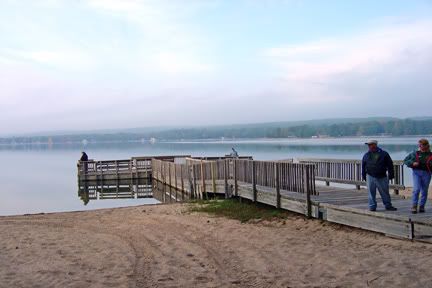
First step in the process is getting the equipment and necessary tools together.
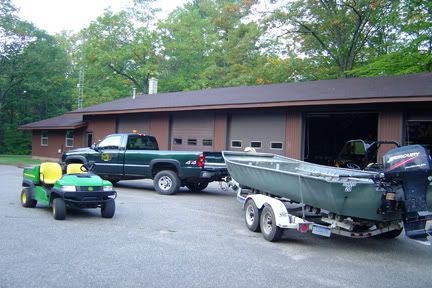
Then after the boat is lanched and brought over to the pier, two people in the boat undo the bolts holding the end railing in place while the rest of us hold on to it. Can't afford to let it slip or it will head for the bottom of the lake in 15ft of water.
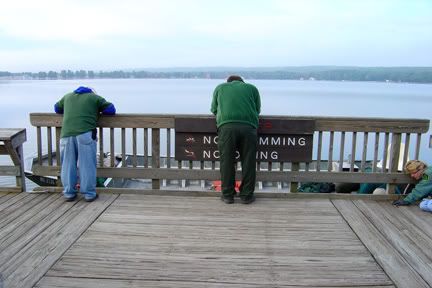
Once the end railing is removed and laid down on the pier, then the removal of the pipes holding the sections in place begins. First a crowobar is lowered down into the casings to snag a grab bar across the top of the pipe and then attach a chain which in turn is attatched to a jack and the pipe is then pulled up
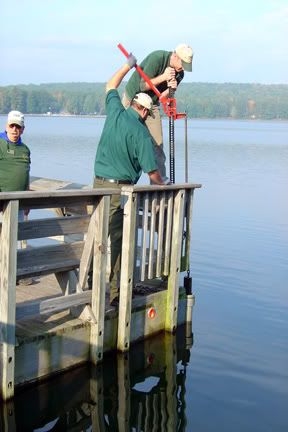
Once enough of the pipe is out of the casing, then it takes some brute strength to pull it out the rest of the way. This pier is out into water taht is approx 15 feetdeep so the first few pipes are very long and VERY slimy from being in the water for 4 months.
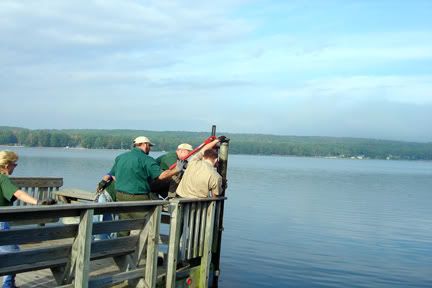
Once the pipes are removed from a section, the boat is then tied bow first onto the section.
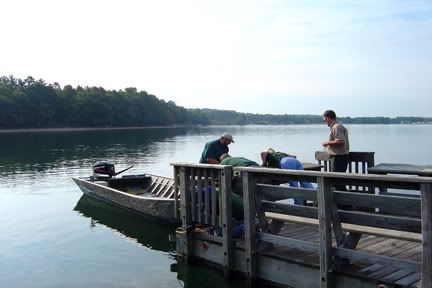
Then these large bolts holding each section together are pulled out and the section floats free.
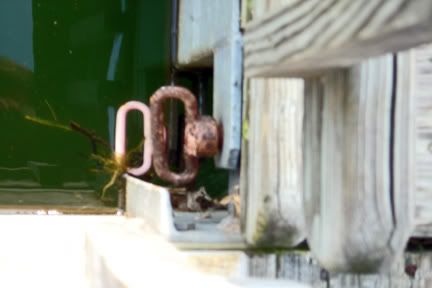
Each section is then pushed by the boat over to the boat launch where it is attached to the truck with a special hitch attachment and pulled up and out of the water on wheels that are built into each section of pier. The reason the sections are pushed rather than towed is so that they can be pushed to shore at the launch.
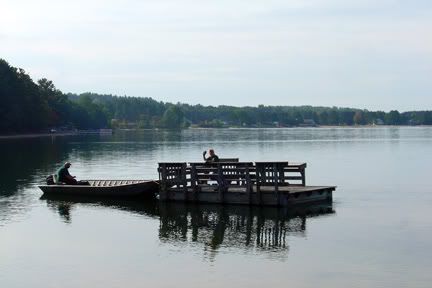
All but two sections are removed and stored in the park's Day Use parking lot till spring comes and it's time to reverse the process and haul it all out and back into the lake.
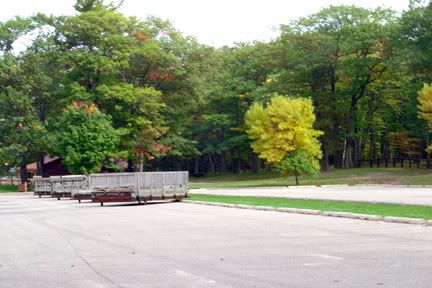
It takes at least three guys to pull those pipes, one person to ride the section over with the boat and attach the rope to toss to two people waiting on shore and one person to handle the boat. So we do need a little crew for this job. I did my share of floating over on the pier sections. That was fun, like riding on a ferry. As you can see, we had a perfectly calm day for doing this. If the wind comes up, it makes it harder. But looking at the western sky when we finished, we got done just in time.
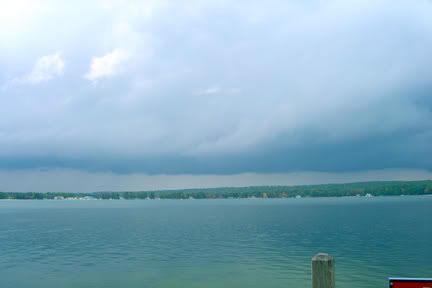
Of the two remaining sections of pier, one is permanently anchored on shore and the other one requires the assistance of an end loader capable of lifting at least 3000 tons to bring it up and set in on shore. Some years if the lake level is high enough, we have been able to also float that section off, but over the past few years, it's hasn't been the case. And all does not go smoothly during removal either. There is always something sticking or refusing to move and an ocassional drop of the crowbar in the drink which than requires fishing to find it and get it back out. And this year one section was just far enough on sand that it required getting the tractor and lifting up a corner to get it free to float out. All in a morning's work.
So anyway, next time you walk out on a fishing pier, you will know a bit about the work involved in those that are hauled out and put back in each spring. Hope you enjoyed out little work bee.



First step in the process is getting the equipment and necessary tools together.

Then after the boat is lanched and brought over to the pier, two people in the boat undo the bolts holding the end railing in place while the rest of us hold on to it. Can't afford to let it slip or it will head for the bottom of the lake in 15ft of water.

Once the end railing is removed and laid down on the pier, then the removal of the pipes holding the sections in place begins. First a crowobar is lowered down into the casings to snag a grab bar across the top of the pipe and then attach a chain which in turn is attatched to a jack and the pipe is then pulled up

Once enough of the pipe is out of the casing, then it takes some brute strength to pull it out the rest of the way. This pier is out into water taht is approx 15 feetdeep so the first few pipes are very long and VERY slimy from being in the water for 4 months.

Once the pipes are removed from a section, the boat is then tied bow first onto the section.

Then these large bolts holding each section together are pulled out and the section floats free.

Each section is then pushed by the boat over to the boat launch where it is attached to the truck with a special hitch attachment and pulled up and out of the water on wheels that are built into each section of pier. The reason the sections are pushed rather than towed is so that they can be pushed to shore at the launch.

All but two sections are removed and stored in the park's Day Use parking lot till spring comes and it's time to reverse the process and haul it all out and back into the lake.

It takes at least three guys to pull those pipes, one person to ride the section over with the boat and attach the rope to toss to two people waiting on shore and one person to handle the boat. So we do need a little crew for this job. I did my share of floating over on the pier sections. That was fun, like riding on a ferry. As you can see, we had a perfectly calm day for doing this. If the wind comes up, it makes it harder. But looking at the western sky when we finished, we got done just in time.

Of the two remaining sections of pier, one is permanently anchored on shore and the other one requires the assistance of an end loader capable of lifting at least 3000 tons to bring it up and set in on shore. Some years if the lake level is high enough, we have been able to also float that section off, but over the past few years, it's hasn't been the case. And all does not go smoothly during removal either. There is always something sticking or refusing to move and an ocassional drop of the crowbar in the drink which than requires fishing to find it and get it back out. And this year one section was just far enough on sand that it required getting the tractor and lifting up a corner to get it free to float out. All in a morning's work.
So anyway, next time you walk out on a fishing pier, you will know a bit about the work involved in those that are hauled out and put back in each spring. Hope you enjoyed out little work bee.